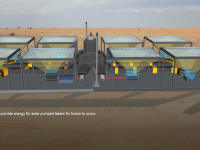Modern Fusion Reactor designs like the Wendelstein 7X utilize magnetic fields that are so complex that it took 19 years just to manufacture the hardware necessary to have them running. Having a reactor which utilizes a system of Holographic lasers which would augment existing “simple” reactor designs could speed up both the experimental process, as well as the developmental process of fusion reactor design.
Universities are already utilizing technologies like machine learning to help optimise reactor design and control, so if a high-power holographic laser were introduced, into existing reactor systems:
1. More discoveries of plasma phenomena could be made.
2. Less lead-time between experiments, as changes in variables could be done in software instead of hardware.
3. Anything that the can be simulated can be run in plasma experiments, even impossible or high-dimensional geometries.
4. Having the laser system be powered via solar concentrators puts less stress on the grid.
The proposed design uses a simple magnetic bottle of 2 electromagnets to house the plasma within the center of the chamber, where the lasers take over and help create filaments of plasma which converge at a point in 3d space which creates a plasma body called a plasmoid. A plasmoid is a phenomenon where loops of current within a plasma twist and kink around eachother to form a toroidal shape, which then shoots out a pair of positive and negative ion beams from its center, which then can be converted into usable energy via a solenoid (since electric current is just moving charges).
The fusion fuel used is a mixture of Boron proton fuel as the by products produce less harmful neutrons, and by-product of fast alpha particles which can be harnessed via a solenoid for a more efficient direct energy conversion over conventional steam turbines.
The laser system uses DLP mirror chips much like those installed in movie projectors. They offer a cheap way to create a “light gate” from which you can create a holographic image of high energy laser light, and use that high adaptable resolution to help control the unpredictable fusion reactions inside the core. The plasma responds to high powered laser pulses from phenomena called plasma wakefield acceleration. Only instead of accelerating ions in one direction/vector, the laser system could make a volumetric “image” of plasma. One advantage to laser holography, is that it offers the ability to manipulate a plasma without having to surrender to a specific magnetic/ electric field geometry which is only tuneable to a degree, as the geometry of the reactor limits the experimental range, and is somewhat fixed until the reactor is disassembles and able to be rebuilt again. This means machine learning algorithms have the potential to utilize this new variability and take over in the fusion experimentation/iteration process. For example the program could create a holographic torus, tweak its size, shape, even make it vibrate and constantly eb-and flow, mirroring the dynamic system like the surface of the sun.
Voting
-
ABOUT THE ENTRANT
- Name:Alex Langensiepen
- Type of entry:individual
- Profession:
- Number of times previously entering contest:4
- Alex's favorite design and analysis tools:Autodesk Alias, Blender, Fusion 360.
- Alex's hobbies and activities:Running and making things
- Alex belongs to these online communities:Coroflot, Behance, Artstation
- Alex is inspired by:I am mostly inspired by nature and science fiction films, together they create an infinite pool of possibilities to discover things from.
- Software used for this entry:Google Sketchup
- Patent status:none








